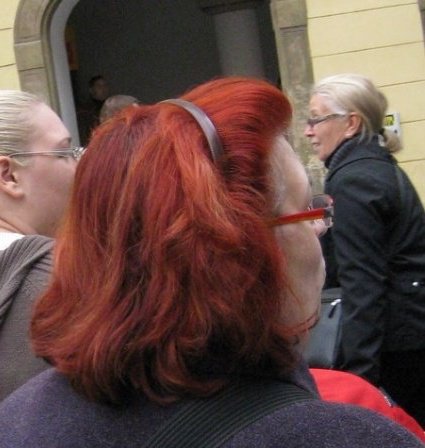
By Caroline Wray
Question: just how inappropriate is it to compare the “Sarajevo Roses” to hairstyles? Because, here’s the thing – you’ll be walking through the streets of Sarajevo, thinking about that scarf in the window or what you’d like to eat for dinner, when you catch a halting splash of crimson.
Some are on the sidewalk. “This is the site of incomprehensible pain,” they whisper, and you feel like you shouldn’t step on them so you sidestep.
Others are atop women’s heads. “Am I closer to tangerine, or maroon?”
The look seems to transcend all the usual barriers: it’s attached to grandmothers as well as teenagers, pixie and mermaid lengths, business professionals and punk rockers.

Apparently, is a phenomenon so established that it has earned its own relatively popular Facebook page. “Sometimes it’s more purple, and sometimes it’s more orange. Sometimes there are unexplicable strips of white or blonde [sic]. And usually, it is uneven and at least a little bit grown out, with some fantastic roots showing,” reads its page description. “The terrible dye job of the Eastern European woman deserves recognition, if not respect.”
And yet, there seems to be no explanation. In fact, studies appear to indicate that red hair discrimination is far more prevalent in this part of the world than admiration. A BBC News article titled “Is Gingerism as bad as racism?” posits that “redheads, as a visible minority not protected by law, have become a target” in the United Kingdom. Searches for red hair spit out articles and advertisements warning against maltreatment from domains such as “Nobullying.com.”
This certainly makes historical sense. During medieval times, folklore dictated that a child with red hair had been conceived during “unclean sex” or during their mother’s period. Female victims of the witch-hunts of the 1500s and 1600s were often burned at the stake simply because of their red hair. As recently as World War II, Hitler banned the marriage of red-heads to one another in order to prevent “deviant offspring.”
Most studies report that the proportions of women coloring hair (somewhere from 60 to 75 percent) are equal in the United States and Europe. And the locals I ask don’t seem to have many opinions on the topic, or even think bottle-red dye jobs are particularly prevalent in comparison to more natural colors.
Maybe I’ve only noticed it because I’ve been flirting over the last several weeks with dying my own hair red. Maybe this is just an indicator of my own self-absorption. But I refuse to believe this isn’t a trend! I just went to the bathroom in this café, and the other woman in line had orange hair. In just one afternoon stroll through Old Town, I counted 32 separate cases. I mean, this city’s population is only 500,000!

Further investigation led me to some potential justifications. Muslim law allows women to dye their hair any color aside from black. A large majority of Sarajevans today identifies as Muslim; perhaps the red hair results from the city’s religious makeup? A 2001 SUNY study on Jewish ethnicity in the United States and Soviet Union reported that a long-standing European stereotype of redheads being Jews persists in Eastern Europe. Might the red hair dye phenomenon, then, indicate diminishing anti-semitism here?
One source, Scottish ex-pat Jim Marshall, told me that he believes Bosnia could be “the next Sweden,” in that its geopolitical location and relative isolation are remarkably similar and it has the potential to become a “cool” market for industry and wealth, if not a global superpower. Studies show that natural redheads, today, are most concentrated in northern European nations. That must be it. Bosnian women are reflecting this potential geopolitical shift in their hair!
Obviously, I’m reaching. Probably, the truest explanation comes from our interpreter, Alen, who shrugged and attributed it to the motion of any fashion trend. “You do it, I do it, you know?”
Regardless: if I’ve learned anything from the streets of Sarajevo, it’s to take extra precaution in selecting the right shade.
Caroline Wray ’17 is in Jonathan Edwards College. Contact her at caroline.wray@yale.edu.